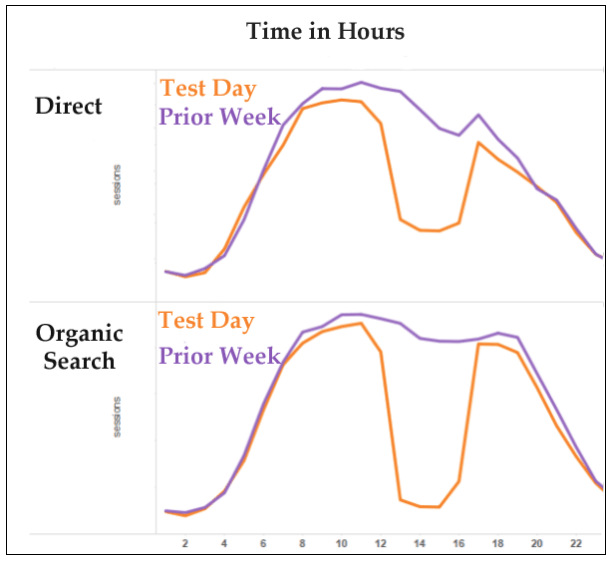Direct Search vs. Organic Traffic
Knowing the source of your web traffic is key when developing a strong digital marketing strategy. However, analytics tools often can’t differentiate between direct search and organic traffic. Here’s where they differ and how you can identify where your traffic is actually coming from.
Being able to differentiate between direct traffic and organic traffic is very important when it comes to managing digital marketing campaigns, analyzing the effectiveness of your existing website, and figuring out new ways to strengthen your SEO status and generate more leads in the future.
In the past, understanding the difference between organic and direct search was relatively simple: any traffic that came from search engines counted as organic, while any traffic that came from users inputting your site's URL into their browser counted as direct.
However, things have changed when Google updated its algorithm. Now, the classification of direct traffic, in particular, has become a little hazier and harder to understand. So let's take a closer look at direct search vs organic traffic to find out the differences.
Need help selecting a company?
Based on your budget, timeline, and specifications we can help you build a shortlist of companies that perfectly matches your project needs. Get started by submitting your project details.
What Is Organic Traffic?
Organic traffic is any traffic that comes from search engines (not including paid ads, such as those that appear at the top of Google pages for certain searches).
In other words, websites have to earn organic traffic through effective inbound marketing and SEO campaigns. Indeed, most inbound marketing campaigns focus on raising levels of organic traffic by increasing Google rankings.
Organic traffic is something that every digital marketer needs to have as a priority, and countless case studies have shown how strong SEO strategies and smart inbound marketing campaigns can help to raise levels of organic traffic exponentially over time.
What Is Direct Search?
Direct search traffic is used to describe any traffic that comes directly to your site. This includes any user who manually enters your web address into their browser or who clicks on Bookmark or Favorite links in their browsers.
High levels of direct traffic can be a great sign, as it means that many people are aware of your brand, know your URL address, and head straight to you for the goods or services that you provide.
However, it can be difficult to accurately track direct search traffic. In 2014, Groupon conducted a study in which they de-indexed their site and manually tracked both organic and direct search levels every hour.

Source: Search Engine Land
They found that their direct traffic was far lower than expected, suggesting that a lot of traffic that has been classified as "direct search" actually may be organic.
This happens because many analytics tools can struggle to identify the source of every single site visitor, and if they can't figure out where the traffic is coming from, it simply gets classified as direct. This can lead to analytics tools showing significantly higher amounts of direct traffic than a site is actually getting.
Where Is “Direct Search Traffic” Really Coming From?
So, if your direct traffic isn't actually direct, where might it be coming from? Here are a few key examples:
- Referral from HTTP Site - If you're still running an unsecured HTTP site, you won't get accurate tracking on visitors from secured HTTPS sites.
- Bad/Broken Redirects or Coding - In many cases, excess direct traffic is caused by simple errors in tracking codes or redirects.
- Apps and Software - Many apps and pieces of software may link users to your site but don't provide any tracking/referral information.
- Other - There are various other sources of falsely-reported direct traffic too. These are only a few examples.
Why Is Identifying Any Misclassifications Important?
Identifying where traffic is coming from because digital marketers need accurate data in order to figure out the next best steps to take.
If you don't actually know the realistic levels of organic and direct search to your site, there's not a lot of use in using analytics tools at all and you could be missing out on major marketing opportunities.
What Can Be Done About It?
A good way to get started is to upgrade your site to the latest HTTPS standard, as HTTP sites are now vastly outdated. You should also stay on top of tagging in your campaigns to get the most accurate traffic reports.
Otherwise, SEO and digital marketing specialists who can help you address any issues you may have with direct search traffic and find out where it's all really coming from. To find the perfect partner for your business:
- Check out online directory pages
- Ask for references
- Have a trial period
This will help you find the perfect SEO partner that can help you differentiate between organic and direct search.
Know the Difference Between Organic and Direct Search to Make the Most of Digital Marketing
As we can see, direct search and organic traffic are two very different things. Having a lot of organic traffic is a clear sign that your SEO and inbound marketing is working well, and having a ton of direct traffic can be a great sign of general brand awareness and industry status.
However, direct traffic can be a little trickier to understand. Businesses must actively take steps to make sure that they use the best analytics and get the most accurate reports. Only then can they truly assess the effectiveness of their digital marketing efforts over time.
Need help selecting a company?
Based on your budget, timeline, and specifications we can help you build a shortlist of companies that perfectly matches your project needs. Get started by submitting your project details.